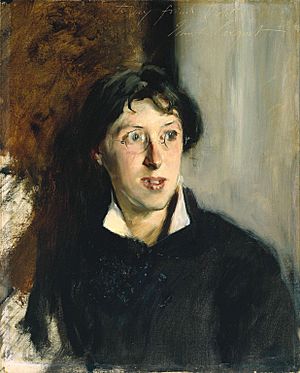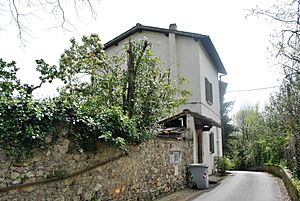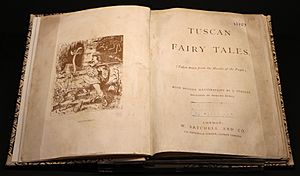Vernon Lee facts for kids
Quick facts for kids
Vernon Lee
|
|
|---|---|

Portrait of Violet Paget by John Singer Sargent
|
|
| Born | Violet Paget 14 October 1856 France |
| Died | 13 February 1935 (aged 78) |
| Occupation | Short-story writer, essayist |
| Nationality | British |
| Genre | Short story, supernatural |
Vernon Lee was the pen name of a British writer named Violet Paget. She was born on October 14, 1856, and passed away on February 13, 1935. People remember her mainly for her spooky stories and her ideas about art and beauty. She wrote many books of essays about art, music, and travel.
Contents
About Vernon Lee
Violet Paget was born in France on October 14, 1856. Her parents were British, living away from their home country. Her mother's first husband was named Lee-Hamilton. Violet used part of his last name to create her pen name, Vernon Lee.
Even though she wrote for English readers, she lived most of her life in Europe. She made many visits to London. But she spent most of her time in Italy.
Life in Italy

Her main home was a villa called Palmerino. It was just outside Florence. She lived there from 1889 until she passed away. During World War I, she had to leave for a short time.
She left her large collection of books to the British Institute of Florence. Visitors can still see her library there today. In Florence, she became good friends with the painter Telemaco Signorini. She also befriended the scholar Mario Praz. She encouraged his love for learning and English books.
Her Views and Interests
Vernon Lee was a strong supporter of women's rights. She often dressed in a boyish style. During the First World War, she believed strongly in peace. She was part of a group that was against war. This group was called the Union of Democratic Control.
She played the harpsichord, which is an old musical instrument. Her love for music is clear in her first big book. It was called Studies of the Eighteenth Century in Italy (1880). In a later edition, she wrote about finding old music as a girl. She was so excited that she listened from the garden. Her mother played the music on the piano inside.
She was seen as an expert on the Italian Renaissance. This was a time of great art and learning. She wrote two books about it. These were Euphorion (1884) and Renaissance Fancies and Studies (1895).
Her Writings
Vernon Lee's short stories often explored themes of ghosts and being possessed. She wrote a ghost story called "A Wicked Voice." She gave this story to the composer Mary Augusta Wakefield in 1887.
Her most famous stories were put together in a book called Hauntings (1890). Her story "Prince Alberic and the Snake Lady" (1895) first appeared in a famous magazine. This magazine was called The Yellow Book.
Art and Feelings
She helped bring a German idea called Einfühlung to English speakers. This word means 'empathy'. It is about understanding how art makes you feel. She used this idea in her studies of aesthetics. Aesthetics is the study of beauty and art.
She worked with her friend, Clementina Anstruther-Thomson, to create her own ideas. They believed that when people look at art, they "empathize" with it. This means the art brings up memories and feelings. It can even cause small, often unnoticed, changes in how you stand or breathe.
Travel and Criticism
Vernon Lee was famous for her many essays about travel. She wrote about Italy, France, Germany, and Switzerland. She tried to capture how places made her feel. She did not just list facts about them.
Like her friend Henry James, she wrote about writers and their readers. She was one of the first to think about how people react to art. She believed that a person's feelings were important when judging art.
She supported the Aesthetic movement. This movement focused on art for art's sake. She wrote many letters to its leader, Walter Pater. She met him in England in 1881. She had also met Oscar Wilde, another famous person from the movement.
Later Life and Legacy
Vernon Lee was against World War I. Her book Satan the Waster showed her strong views. Because of this, some younger writers did not want to be around her.
However, since the 1990s, her work has been rediscovered. Especially by people studying women's history. Many of her personal letters are kept safe at Somerville College Library.
Works
- Studies of the Eighteenth Century in Italy (1880)
- A Culture-Ghost; or, Winthrop's Adventure (1881)
- Belcaro, Being Essays on Sundry Aesthetical Questions (1881)
- Ottilie: An Eighteenth Century Idyl (1883)
- The Prince of the Hundred Soups: A Puppet Show in Narrative (1883)
- The Countess of Albany (1884)
- Miss Brown (1884) novel
- Euphorion: Being Studies of the Antique and the Mediaeval in the Renaissance (1884)
- Baldwin: Being Dialogues on Views and Aspirations (1886)
- A Phantom Lover: A Fantastic Story (1886)
- Juvenilia, Being a second series of essays on sundry aesthetical questions (1887)
- Hauntings. Fantastic Stories (1890)
- Vanitas: Polite Stories (1892)
- Althea: Dialogues on Aspirations & Duties (1894)
- Renaissance Fancies And Studies Being A Sequel To Euphorion (1895)
- Art and Life (1896)
- Limbo and Other Essays (1897)
- Genius Loci: Notes on Places (1899) travel essays
- The Child In The Vatican (1900)
- In Umbria: A Study of Artistic Personality (1901)
- Chapelmaster Kreisler A Study of Musical Romanticists (1901)
- Penelope Brandling: A Tale of the Welsh Coast in the Eighteenth Century (1903)
- The Legend of Madame Krasinska (1903)
- Ariadne in Mantua: a Romance in Five Acts (1903)
- Hortus Vitae: Essays on the Gardening of life (1903)
- Pope Jacynth – And Other Fantastic Tales (1904)
- The Enchanted Woods, and Other Essays on the Genius of Places (1905) travel essays
- Sister Benvenuta and the Christ Child, an eighteenth-century legend (1906)
- The Spirit of Rome: Leaves from a Diary (1906)
- Ravenna and Her Ghosts (1907)
- The Sentimental Traveller . Notes on Places (1908) travel essays
- Gospels of Anarchy & Other Contemporary Studies (1908)
- Laurus Nobilis: Chapters on Art and Life (1909)
- In Praise of Old Gardens (1912) with others
- Beauty and Ugliness and Other Studies in Psychological Aesthetics (1912) with Clementine Anstruther-Thomson
- Vital Lies: Studies of Some Varieties of Recent Obscurantism (1912)
- The Beautiful. An Introduction to Psychological Aesthetics (1913)
- The Tower of the Mirrors and Other Essays on the Spirit of Places (1914) travel essays
- Louis Norbert. A Twofold Romance (1914) novel
- The Ballet of the Nations. A Present-Day Morality (1915)
- Satan the Waster: A Philosophic War Trilogy (1920)
- The Handling of Words and Other Studies in Literary Psychology (1923)
- Proteus or The Future Of Intelligence (1925)
- The Golden Keys and Other Essays on the Genius Loci (1925) travel essays
- The Poet's Eye, Notes on Some Differences Between Verse and Prose (Hogarth Press, 1926)
- For Maurice. Five Unlikely Stories (1927)
- Music and its Lovers: An Empirical Study of Emotional and Imaginative Responses to Music (1932)
Books Published After Her Death
- Snake Lady and Other Stories (1954)
- Supernatural Tales (1955)
- The Virgin of the Seven Daggers – And Other Chilling Tales of Mystery and Imagination (1962)
Bilingual Editions
- Unsere Liebe Frau der Sieben Dolche / The Virgin of the Seven Daggers, bilingual (German/English) edition. Calambac Verlag, Saarbrücken 2017. ISBN: 978-3-943117-92-9.



